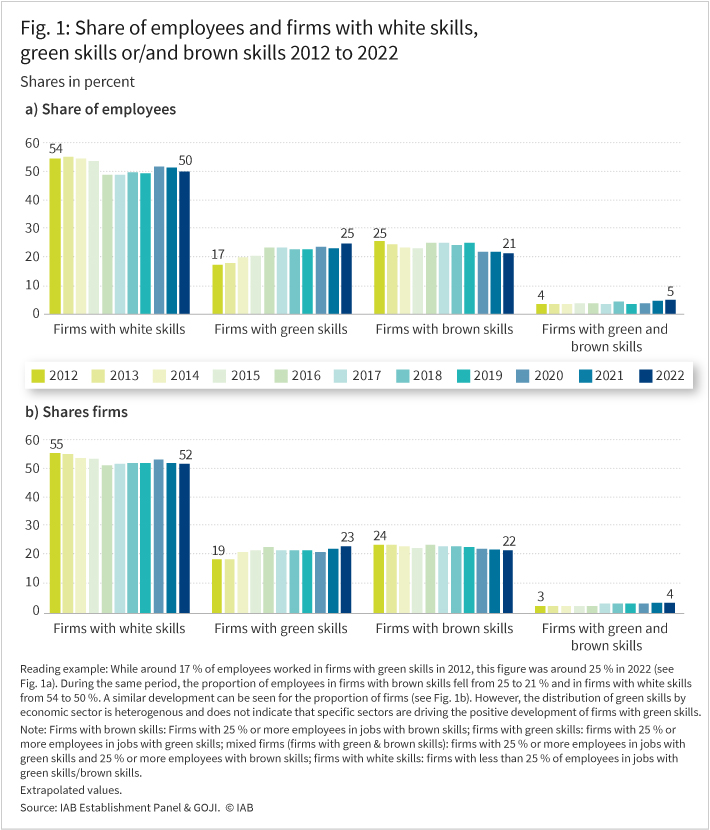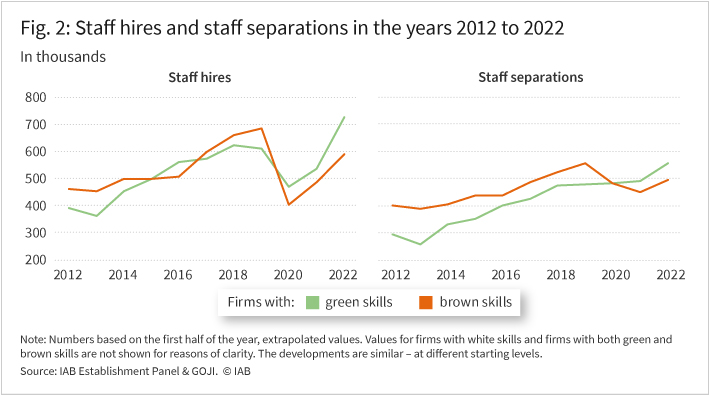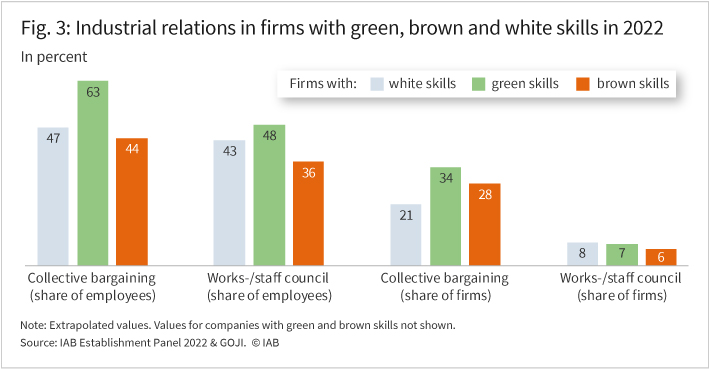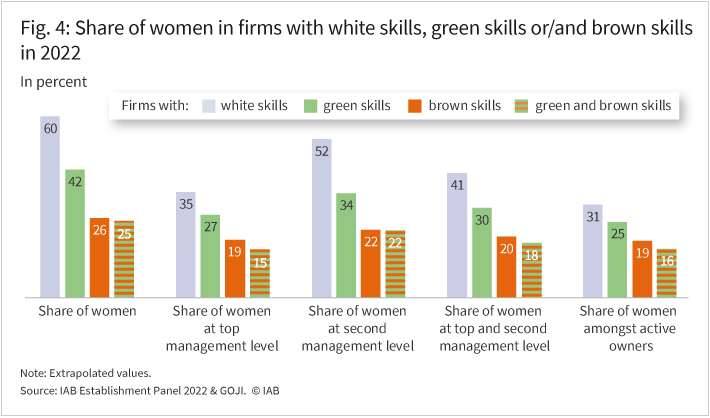30. June 2025 | Digital and ecological transformation
Firms in the green transition

Due to the green transition, environmentally or climate-friendly skills (“green skills”) are increasingly in demand on the labour market. Firms in Germany are positioned very differently in this regard. Some firms have a high green-skills potential due to the occupational profile of their staff; some firms have started transitioning and are currently changing their skills-base through vocational training and further education, as well as by altering their personnel structure. However, quite a few firms also possess a relatively high proportion of occupational skills that are, due to their product- or service-offering, more environmentally/climate-damaging (through the provision of “brown skills”) and are thus under an even higher pressure to transform. But even in these firms, tasks are evolving in line with transformation requirements – partly due to changing legal and economic frameworks.
In order to trace the importance and development of green skills in firms in recent years, this study aggregates the Greenness of Jobs Index (GOJI) generated at the occupational level to the level of the firm (see Info Box: Data Source).
The aggregation of the GOJI at firm level makes it possible to analyse how the proportion of firms and their employees with significant shares of green, brown and white skills has developed since 2012. The results show that firms with green skills are becoming more predominant. The analysis suggests that firms with green skills may be somewhat better positioned to compete for labour, although there is no evidence of climate quitting, i.e. of employees leaving brown employers in favour of green ones. However, the data shows that women are more frequently represented in firms with green skills than in those with brown skills. This could indicate that firms with green skills are more attractive to women.
Firms with green skills are tending to increase in importance
Using the firm typology based on the IAB Establishment Panel combined with administrative data on the firms’ workforces (see Info Box: Data Sources), the development of firms can be traced from 2012 to the end of 2022. Measured by the total number of employees and firms in Germany, firms with green skills are tending to increase in importance, whilst the proportions of firms with brown skills and with white skills are tending to decline (see Figure 1).

Recruitments particularly high in firms with green skills
In the context of increasing labour shortages, the growth of firms and employees with green skills cannot be considered independently of the general labour-market situation, which has, overall, developed positively in recent years. Since 2005, the number of staff hires – with the exception of the financial and economic crisis in 2009 (not shown here) and the Covid-19 crisis in 2020 – has always been higher than the number of staff separations (see Figure 2). This applies to all types of firms. However, it is clear from Figure 2 that the number of staff hires in firms with green skills in particular increased above average since 2020; reached a new high in 2022 and has surpassed the absolute number of staff hires in firms with brown skills. Staff separations have also increased in view of the general increase in employment, but less sharply.

On the other hand, in relation to the increasing difficulties in recruiting staff, it is apparent that staff separations are predominantly determined not by firms, but by employees: resignations by employees over the past few years – with the exception of the pandemic years 2020 and 2021 – have increased in importance and are a major factor in determining workforce turnover in Germany. This connection is also reflected in the fact that staff turnover is increasingly reported by German firms as being a problem. There is, however, no clear difference when comparing firms with green skills and brown skills. Thus, the theory of “climate quitting” cannot be confirmed based on the available data up to 2022.
Higher levels of industrial relations amongst firms with green skills – a competitive advantage?
With regard to industrial relations, it can be observed that firms with green skills are more likely to have collective agreements and co-determination than firms with brown skills (see Figure 3). 63 percent of employees working for firms with green skills have collective agreements, and 48 percent have a works council or staff council. In firms with brown skills, the proportion of employees with collective agreements is significantly lower at 44 percent; 36 percent of employees have a works/staff council. As argued by Uwe Jirjahn and colleagues in 2018 and by Steffen Müller and colleagues in 2021, firms with collective agreements and company co-determination could hold an advantage in the competition for skilled workers and labour: On average, these firms have higher productivity and less staff turnover, offer higher wages and more working-time flexibility. Following this argument, firms with green skills, with their higher coverage of collective agreements and company co-determination bodies, could be somewhat better positioned in the competition for workers. However, it should be noted that the effects of industrial relations are not easy to separate from the influence of other firm characteristics such as firm size, since there are only a few large firms that are not bound by collective agreements or do not have company co-determination in Germany. In this respect, further analyses are pending, taking into account in particular the firm size and industry structure of the firms in order to identify any competitive advantages of firms with green skills.

More women in firms with green skills – also in management roles
Women are more strongly represented in firms with green skills than in firms with brown skills. However, those firms with the highest proportion of women remain those with white skills. This can be explained in particular by the fact that the proportion of women in service occupations (e.g. in the health and education sectors) is above average and these occupations are so far not classified as having either green skills or brown skills – i.e. they are classified as “occupations with white skills” (see Figure 4). The higher proportion of women in firms with green skills is also accompanied by higher proportions of women as active business owners and women in management positions compared to firms with brown skills. The proportion of women amongst trainees is also higher in firms with green skills than in those with brown skills.

Conclusion
Overall, this study shows that the green transition brings both challenges and opportunities for firms. Whilst labour shortages remain a problem for all firms, firms with green skills may be better positioned to meet these challenges and benefit from the opportunities that arise.
The more widespread collective bargaining coverage and employee participation, the higher share of women in firms with green skills as well as the slightly but not statistically significant lower recruitment problems of firms with green skills can at least cautiously be interpreted as indications of slightly higher attractiveness to the advantage of firms with green skills. However, further research is needed on this issue.
At the same time, many firms that perform so far predominantly environmentally- or climate-damaging activities might still be needed in the future, albeit in a more ecologically sustainable version. In order for these firms to be well-prepared for the green transition and to continue to be attractive as employers, two changes are necessary: first, firms in which brown skills still play a major role must operate in a more environmentally and climate-friendly manner overall and invest in eco-innovations. Second, firms should already integrate the teaching of green skills into vocational training and further education. Even amongst “neutral” white-skill firms, environmentally and climate-friendly activities will be added over time, and firms with green skills will also have to continue to transform, which will also lead to adjustments in business models and in training.
Data Sources
This study uses a measure for the proportion of environmentally and climate protection-relevant activities in occupations – the Greenness of Jobs Index (GOJI) – which was developed in 2019 and has recently been expanded with the dimensions of brown tasks and white tasks. The measure is obtained through a systematic classification (“text mining”) of task/skill competencies in the German Federal Employment Agency’s BERUFENET database, which contains detailed descriptions of all single occupations in Germany.
The GOJI shows the level of (potential) environment-related tasks for the years 2012 to 2022. To take account of the fact that an occupation can include both green and brown tasks, the GOJI used in this study is calculated as the net share of environmentally/climate-friendly tasks (green tasks) and environmentally/climate-damaging tasks (brown tasks) in the total number of all tasks of an occupation, i.e. the positive and negative proportions are added together to calculate the index. This results in a net value on which the division into the groups “occupations with green skills (index value > 0), occupations with white skills (index value = 0) and occupations with brown skills (index value < 0)” is based.
In each occupation, environmentally or climate-friendly activities, i.e. new green skills, can be added over time or brown skills can be eliminated. The underlying competency requirements of BERUFENET are to be understood as “potentials” that can usually be exercised in an occupation. Whether and to what extent the specific skill (e.g. the installation of heat pumps) is actually performed, depends on the requirement-profile of the respective job.
In the concept of the GOJI, tasks and skills can be seen as two sides of the same coin: the occupations employed in a firm are a proxy for the tasks they demand and perform. At the same time, occupations are also a proxy for the supply of skills, as workers acquire skills through occupational education, training and experience.
To measure firms’ task-based “greenness”, GOJI is aggregated at the establishment level using administrative data from the Federal Employment Agency (Employee History, BeH), weighted by the number of employees and their respective GOJI values. The resulting GOJI value for each establishment is then linked to data from the IAB Establishment Panel Survey (IAB-BP). The IAB-BP is a representative employer survey on establishment determinants of employment. The survey has been carried out in West Germany since 1993 and in East Germany since 1996. It is a central source for labour-demand analyses in Germany. Every year, from the end of June to October, around 15,500 establishments from all sectors and size categories are surveyed nationwide. Strictly speaking, we analyse establishments/ operating sites/ plants, but for brevity we use the term ‘firm’ throughout the article.
Distinguish Green, Brown and White Skills
The distinction between green skills and brown skills is increasingly used in the scientific literature to examine the labour-market effects of the green transition, in particular regarding changes in workforce-skills. The distinction is crucial for understanding how employees and firms must adapt in order to achieve the ecological sustainability goals while remaining economically viable. In particular, the literature highlights the need to develop green skills whilst managing the conversion or reduction of brown skills (see Urban et al. 2023, Broome et al., 2022, Vona 2021). In its taxonomy, the European Commission has introduced the term “white skills” alongside green skills and brown skills, which has now also been taken up by the OECD (EC 2022, OECD 2023). White skills are referred to as skills which, “… neither increase nor reduce the impact of human activities on the environment” (EC 2022, p. 4) and are therefore considered neutral from an ecological point of view.
In Brief
- Efforts to mitigate climate change and promote environmental sustainability have far-reaching implications for firms and their employees. These efforts require firms to adapt their business models and processes to meet the demands of a greener economy.
- At the same time, firms are facing an increasing shortage of skilled labour. It has become particularly challenging for firms to find employees with the necessary environmentally and climate-friendly skills.
- In order to trace the importance and development of green skills in firms in recent years, this study aggregates the Greenness of Jobs Index (GOJI), which is generated at the occupational level, to the level of the firm. This makes it possible to analyse how the proportion of firms and their employees with significant shares of green, brown and white skills has developed since 2012.
- The results show that firms with green skills are tending to gain in importance. The analysis suggests that firms with green skills may be somewhat better positioned to compete for employees.
- Furthermore, the data shows that women are more frequently represented in firms with green skills than in those with brown skills. This could indicate that firms with green skills are more attractive to women.
- However, so far there is no evidence of “climate quitting”, i.e. of employees leaving brown establishments in favour of green firms.
- Overall, the study shows that the green transition brings both opportunities and challenges for firms. Whilst labour shortages are a problem across the board, firms with green skills may be better positioned to meet these challenges and benefit from the opportunities that arise.
Literature
Brixy, Udo; Janser, Markus und Mense Andreas (2023): Ausbildungsmarkt und ökologische Transformation: Auszubildende entscheiden sich zunehmend für Berufe mit umweltfreundlichen Tätigkeiten. IAB-Kurzbericht No 19.
Broome, Molly; Cellini, Stefano; Henehan, Kathleen; McCurdy, Charlie; Riom, Capucine; Sivropoulos-Valero, Anna, and Guglielmo Ventura (2022): Net zero jobs: The impact of the transition to net zero on the UK labour market, The Resolution Foundation.
European Commission (2022): Green Skills and Knowledge Concepts: Labelling the ESCO Classification – Technical Report 2022. European Commission: Employment, Social Affairs and Inclusion, Green Skills and Knowledge – Labelling ESCO.
Janser, Markus (2019): The greening of jobs: Empirical studies on the relationship between environmental sustainability and the labor market, Bamberg.
Janser, Markus (2025): The Greenness of Jobs Index (GOJI): A Task-Based Index to Analyse the Impact of the Green Transition on the Labour Market, Mimeo.
Jirjahn, Uwe and Stephen Smith (2018): Nonunion employee representation: Theory and the German experience with mandated works councils. In: Annals of Public and Cooperative Economics, pp. 201-234.
Müller, Steffen and Georg Neuschäffer (2021): Worker Participation in Decision-making, Worker Sorting, and Firm Performance. In: Industrial Relations No 60, pp.436-478.
OECD (2023): Assessing and Anticipating Skills for the Green Transition: Unlocking Talent for a Sustainable Future, Getting Skills Right, OECD Publishing.
Tyros, Stefanos; Andrews, Dan and Alain de Serres (2023). Doing green things: skills, reallocation, and the green transition”. OECD Economics Department Working Papers, No. 1763, OECD Publishing.
Urban, Patricia; Rizos, Vasileios; Ounnas, Alexandre; Kassab, Amin and Hayk Kalantaryan (2023): Jobs for the green transition: definitions, classifications and emerging trends. CEPS.
Vona, Francesco (2021): Labour markets and the green transition: a practitioner’s guide to the task based Approach, Vol. 126681, Publications Office of the European Union.
picture: Westend61/stockadobe.com
DOI: 10.48720/IAB.FOO.20250630.01
Janser, Markus; Hohendanner, Christian; Lehmer, Florian (2025): Firms in the green transition, In: IAB-Forum 30th of June 2025, https://iab-forum.de/en/firms-in-the-green-transition/, Retrieved: 6th of January 2026
Diese Publikation ist unter folgender Creative-Commons-Lizenz veröffentlicht: Namensnennung – Weitergabe unter gleichen Bedingungen 4.0 International (CC BY-SA 4.0): https://creativecommons.org/licenses/by-sa/4.0/deed.de
Authors:
- Markus Janser
- Christian Hohendanner
- Florian Lehmer

 Dr Markus Janser is a senior researcher at the IAB.
Dr Markus Janser is a senior researcher at the IAB. Christian Hohendanner is a research associate at the IAB since May 2005
Christian Hohendanner is a research associate at the IAB since May 2005 Dr Florian Lehmer is a senior researcher at the IAB`s "Occupations in the Transformation" research unit.
Dr Florian Lehmer is a senior researcher at the IAB`s "Occupations in the Transformation" research unit.